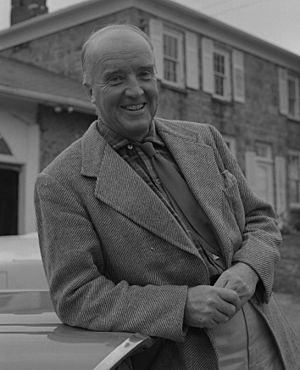Charles Best (medical scientist) facts for kids
Quick facts for kids
Charles Herbert Best
|
|
|---|---|

Best, c. 1959
|
|
| Born | February 27, 1899 West Pembroke, Maine, U.S.
|
| Died | March 31, 1978 (aged 79) |
| Nationality | Canadian |
| Alma mater | University of Toronto |
| Known for | Co-discoverer of insulin |
| Spouse(s) |
Margaret Mahon (1900–1988)
(m. 1924) |
| Children | 2 |
| Awards |
|
| Scientific career | |
| Fields | |
Charles Herbert Best (February 27, 1899 – March 31, 1978) was an American-Canadian medical scientist. He is best known for helping to discover insulin, a very important medicine for treating diabetes.
Contents
About Charles Best
Charles Best was born in West Pembroke, Maine, in the U.S. on February 27, 1899. His father, Herbert Best, was a doctor. His mother, Luella Fisher, was a talented singer.
When Charles was young, his aunt became very sick with diabetes and later passed away. This sad event made him want to study medicine. He decided to go to the University of Toronto in Canada in 1915 to become a doctor.
His studies were paused when he joined the Canadian Army during World War I. He served as a soldier. After the war, he returned to the University of Toronto to finish his degree.
In 1924, Charles Best married Margaret Hooper Mahon in Toronto. They had two sons. One son, Henry Best, became a well-known historian. His other son, Charles Alexander Best, became a politician and a scientist.
Charles Best passed away on March 31, 1978, in Toronto. He is buried near Sir Frederick Banting, his partner in the discovery of insulin.
Discovering Insulin

In 1915, Charles Best moved to Toronto, Canada. He began studying for a science degree at the University of Toronto. After serving in the army, he finished his studies in physiology and biochemistry.
In 1921, when he was just 22 years old and still a medical student, he started working with a surgeon named Dr. Frederick Banting. They worked together at the University of Toronto. Their goal was to find a treatment for diabetes.
Dr. Banting wanted to try isolating something from the pancreas of dogs. This substance, they hoped, could help people with diabetes. J.J.R. Macleod, a professor at the university, allowed them to use his lab. He also gave them ten dogs and two student assistants: Charles Best and Edward Clark Noble.
Best and Noble took turns helping Banting. Best worked with Banting during the first four weeks. Together, Banting and Best worked hard to find a way to get the special substance from the pancreas.
In December 1921, another scientist named James Collip joined their team. He helped them make the pancreatic extract purer. In January 1922, they gave their extract to a 14-year-old boy named Leonard Thompson who had severe diabetes. At first, he had a bad reaction. But Collip soon made the extract much purer and safer. This purified substance was named insulin.
Banting, Best, and Collip shared the patent for insulin. They sold it to the University of Toronto for just one dollar. This meant that the life-saving medicine could be made available to everyone.
In 1923, the Nobel Prize in Medicine was given to Banting and J. J. R. Macleod for the discovery of insulin. Charles Best and James Collip were not included in the award at first. However, Banting chose to share half of his prize money with Best. Macleod also shared his prize money with Collip. Later, in 1972, the Nobel Foundation recognized that leaving Best out was a mistake.
Professor and Later Work
Charles Best became a professor of physiology at the University of Toronto in 1929. He took over from Macleod.
During World War II, he helped set up a Canadian program. This program collected and used dried human blood serum. This was very important for treating injured soldiers. Later in his life, he advised the Medical Research Committee of the United Nations World Health Organization.
Awards and Honours

Charles Best received many awards and honours for his important work. He was recognized by many scientific groups around the world.
Some of his honours include:
- He was made a Companion of the Order of Canada in 1967. This was for his great contributions to medicine, especially for helping discover insulin.
- He was also made a member of the Order of the Companions of Honour in 1971.
- He was a fellow of the Royal Society of London and the Royal Society of Canada.
- In 1994, he was added to the Canadian Medical Hall of Fame.
- In 2004, he was inducted into the National Inventors Hall of Fame.
Several schools are named after him, including Dr. Charles Best Secondary School in British Columbia and Charles H. Best Middle School in Toronto. His birthplace in Maine is also a historic site.
Charles Best also received many honorary degrees from universities around the world. These degrees recognized his amazing contributions to science and medicine.
See also
 In Spanish: Charles Best para niños
In Spanish: Charles Best para niños
- Nicolae Paulescu

